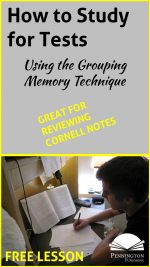How to Memorize Using the Grouping Technique
The grouping technique (also referred to as the chunking strategy) can be an effective tool to help you memorize items that can be placed into categories. We know from recent hemispheric brain research that our brains act as computer file folders, slotting newly learned information in the same file as already-learned information that fits within that same file. If we take the time to organize new information in same way that our brains do, we can enhance our retention of that information.
This simple memory technique will help students of all ages place many items into the long term memory. Using the grouping technique, the specific details of a lecture or reading can be organized into meaningful and memorable categories. Grouping is an effective strategy for reviewing notes and chunking information into memorable categories for test preparation. Why not score core higher on tests and make study fun by learning the way our brains are organized?
The categories we develop to remember similar items don’t have to be organized by content. Any similarities can be used to classify items as a group. For example, a group of people could be classified according to sex, body size, color of skin, eye or hair color, introverted-extroverted—the possibilities are endless.
Let’s learn how to use the Grouping Technique to remember a list of nine items. You are driving into work and your friend phones to tell you that you’ve been invited to  go on a backpacking trip next weekend. “Sure, I’ll remember what to bring,” you respond to your friend. The equipment list includes the following:
go on a backpacking trip next weekend. “Sure, I’ll remember what to bring,” you respond to your friend. The equipment list includes the following:
- tent
- flashlight
- stove
- matches
- sleeping bag
- fuel
- utensils
- ground cloth
- food
At first glance, the equipment items might appear to be quite random and you may be thinking that you will have to sacrifice your pride and call your friend back later to remind you of some of the items the backpacking list. After all, if you are responsible for bringing the food, you don’t want to forget that item! But, instead, you take a few moments to apply the Grouping Technique and you have the list memorized perfectly. You simply categorize the items into these groups:
Sleeping
- sleeping bag
- tent
- ground cloth
Light/Fire
- matches
- stove
- flashlight
- fuel
Eating
- food
- utensils
Works, doesn’t it? Notice that the categories do not have to contain equal numbers of the similar items. Also, a few exceptions would certainly be easier to remember than memorizing the entire list of information as random, un-related items.
For abstract concepts, try substituting them with concrete objects to place them within your groups. For example, it is easier to substitute and place the concrete Liberty Bell into a category than the concept of “freedom.”
Not only does the grouping memory technique help convert short-term memory into long-term memory, grouping also helps us organize and synthesize seemingly unrelated information. By comparing and analyzing details, we can form main ideas. Perfect for pre-writing and literary analysis.
Students using Cornell Notes and the AVID (Advancement via Individual Determination) strategies will especially appreciate the grouping memory technique as a review and organizational aid. For example, from a lecture on Spanish colonization of the Americas, a student might organize the narrative notes into, say, these categories: explorers, discoveries, indigenous peoples, successes, failures. What a great way to organize notes for memorable test study.
Memorizing using the Grouping Technique will enable you to retain the memory of many seemingly unrelated items. Frequent rehearsal of the categories and their items will place the information into your long-term memory. Useful for upcoming tests, speeches, lectures, conversations, party planning, shopping lists? I should say so.
Check out these other brief articles on helpful memorization techniques: catch sentences, catch words, linking, association, This Old Man, and location.
The author’s Essential Study Skills is the study skill curriculum that teaches what students need to know to succeed and thrive in school. Often, the reason why
students fail to achieve their academic potential is not because of laziness or lack of effort, but because they have never learned the basic study skills necessary for success.
The 56 lessons in Essential Study Skills will teach your students to “work smarter, not harder.” Students who master these skills will spend less time, and accomplish more during homework and study time. Their test study will be more productive and they will get better grades. Reading comprehension and vocabulary will improve. Their writing will make more sense and essays will be easier to plan and complete. They will memorize better and forget less. Their schoolwork will seem easier and will be much more enjoyable. Lastly, students will feel better about themselves as learners and will be more motivated to succeed. Essential Study Skills is the ideal curriculum for study skill, life skill, Advocacy/Advisory, Opportunity Program classes. The easy-to-follow lesson format of 1. Personal Assessment 2. Study Skill Tips and 3. Reflection is ideal for self-guided learning and practice. Contact the publisher for affordable site licenses.

